SEO
8 Most Important Types of Keywords for SEO
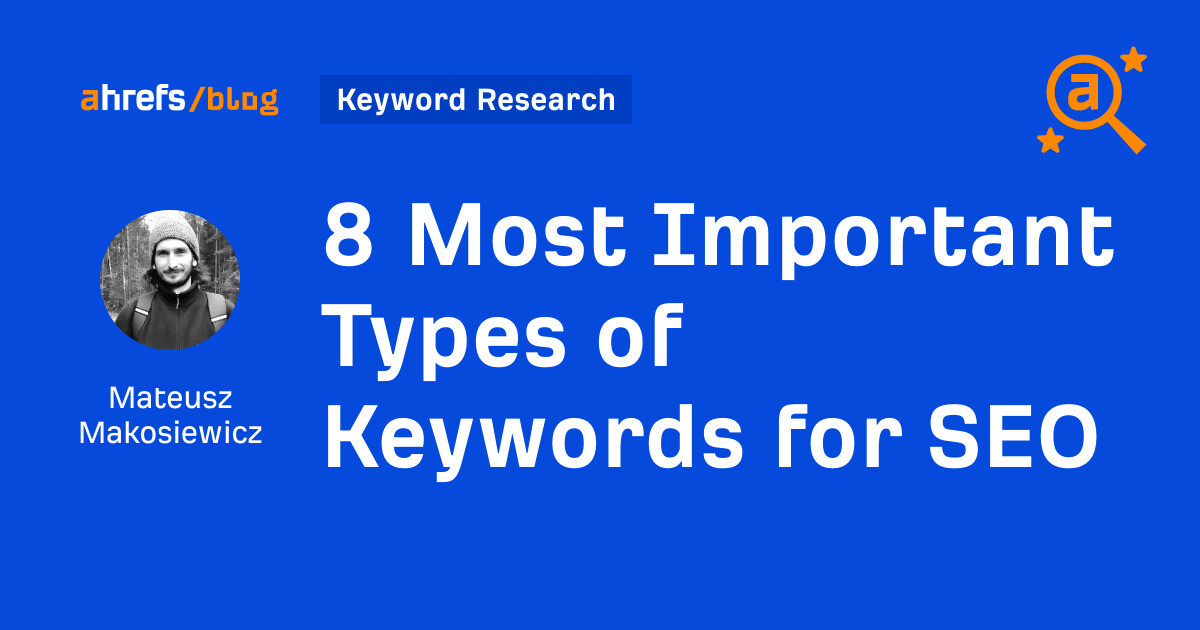
We’ll take a look at the types of organic keywords everyone interested in SEO should know.
If you just want a quick overview of the types, see the cheat sheet below. Read the full article to learn more about their importance and how to find them for your SEO projects.
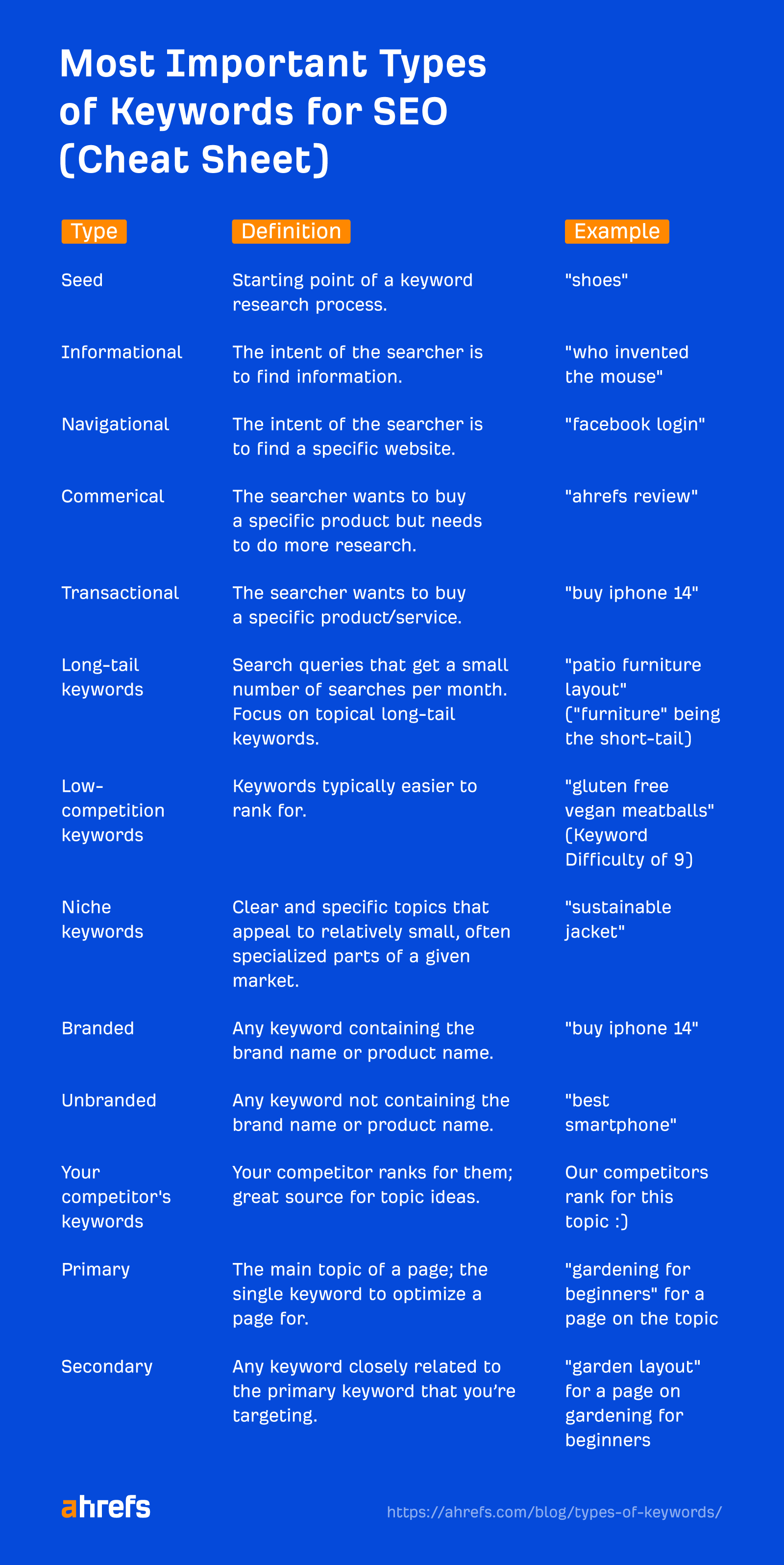
Seed keywords are words or phrases that you can use as the starting point in a keyword research process to unlock more keywords.
If lucrative keywords are the output of keyword research, seed keywords are the input.
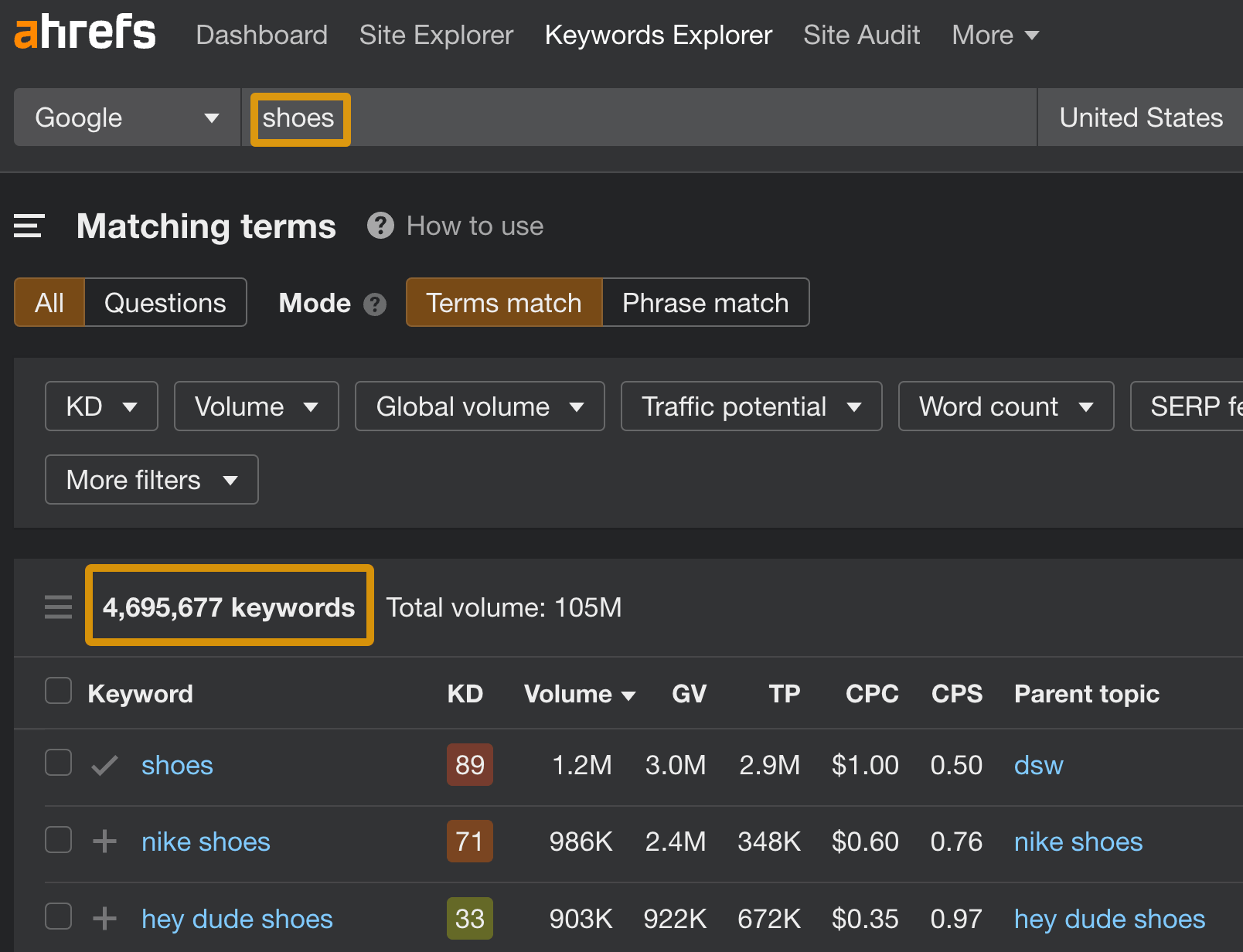
How to find
There are a lot of ways you can come up with good seed keywords:
- Brainstorming
- Investigating competitors’ keywords
- Looking at website navigation menus
- Observing language people use on social media
And more.
Let’s do a quick example. Say you want to start a food blog. You come to a competitor’s blog to look for ideas, and you find a recipe for “vegan meatballs.” You can write a similar recipe or use that as a seed keyword to find out if people search for any variations of the dish. Here are a few you’ll find in Ahrefs’ Keywords Explorer.
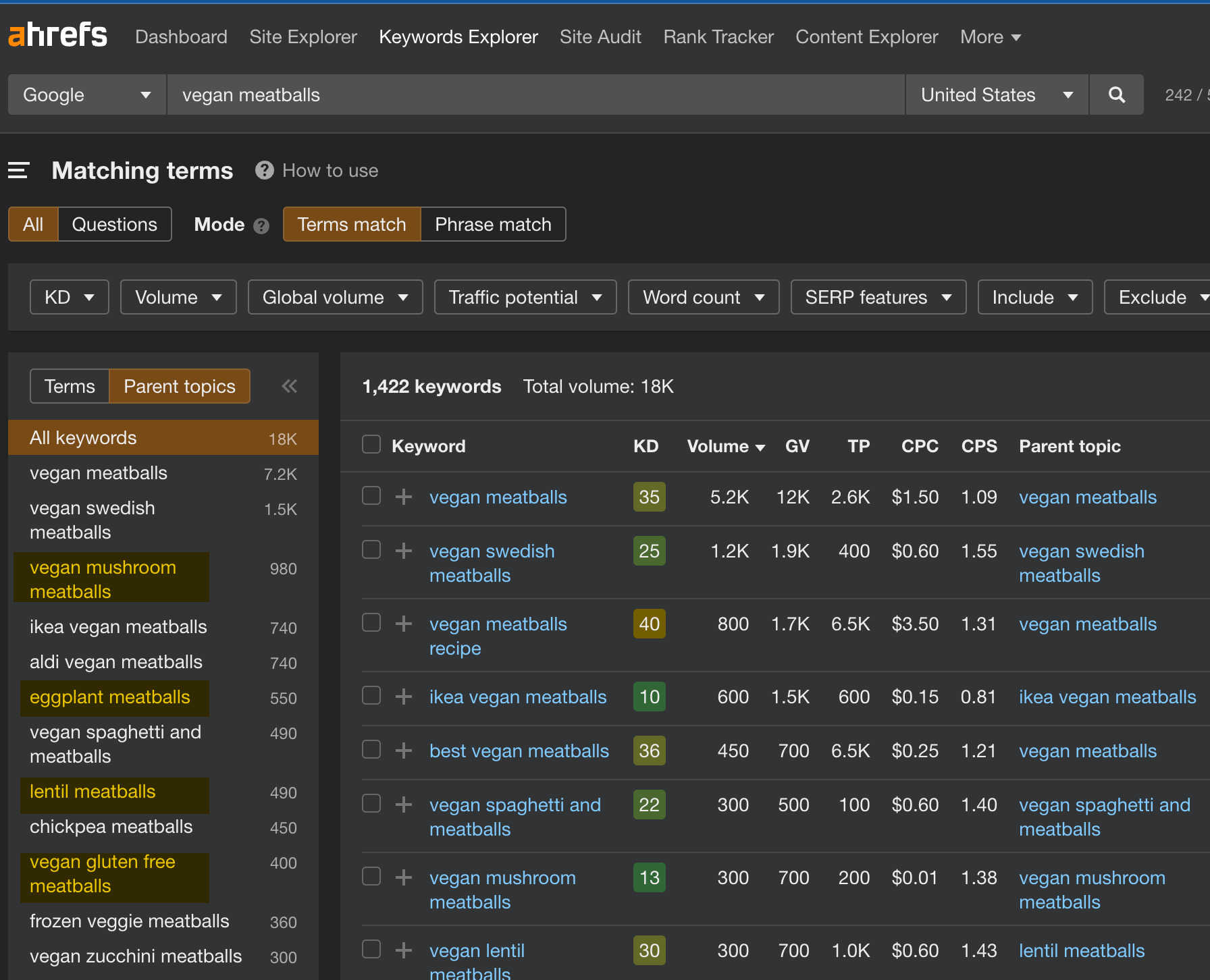
In our other resources, you will find more great seed keyword sources with detailed instructions:
Search intent is the reason behind the search query (i.e., keyword). It’s what people expect to find by using a keyword in a search engine.
Roughly speaking, we can differentiate four basic types of intent keywords:
- Informational – The searcher is looking for information, e.g., “who invented the mouse.”
- Navigational – The intent is to find a specific website, e.g., “facebook login.”
- Commercial investigation – The searcher wants to buy a specific product but needs to do more research, e.g., “ahrefs review.”
- Transactional – Pure buying mode, e.g., “buy iphone 14.”
On top of that, we’ve got so-called high-intent keywords that indicate the user is close to making a purchase; commercial investigation and transactional keywords combined.
Note
The more general the keyword, the more likely it will show a mixed intent SERP. For example, if you Google “coffee,” you will see nearby coffee shops, a couple of big coffee brands, and articles on coffee. Check out our guide on mixed search intent to learn more.
How to find
You can use modifier words. Here are a few ideas:
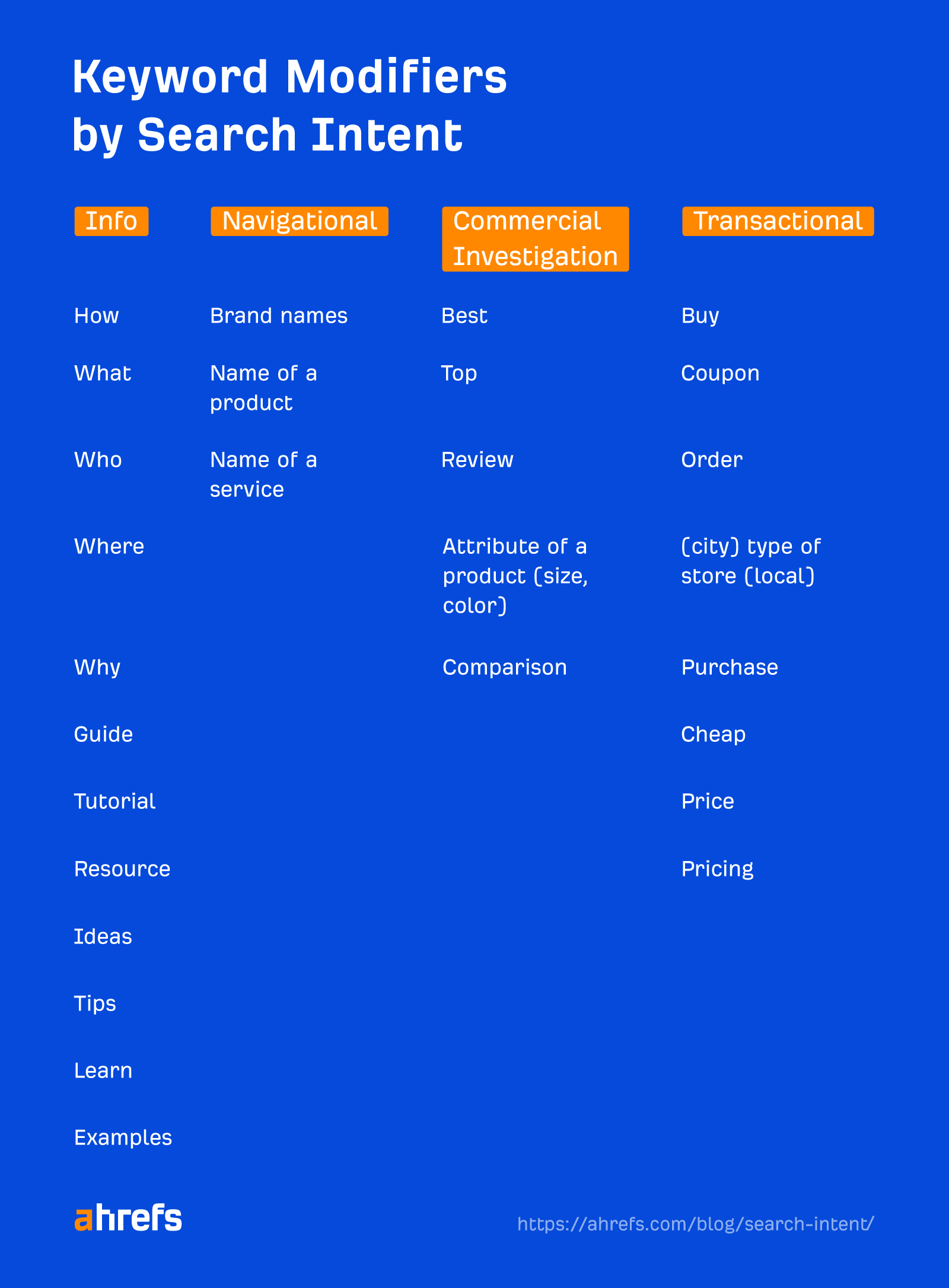
And here’s how the process would look in Keywords Explorer:
- Enter a seed keyword
- Go to the Matching terms report
- Use your modifier words in the Include filter; make sure to set the filter to “Any”
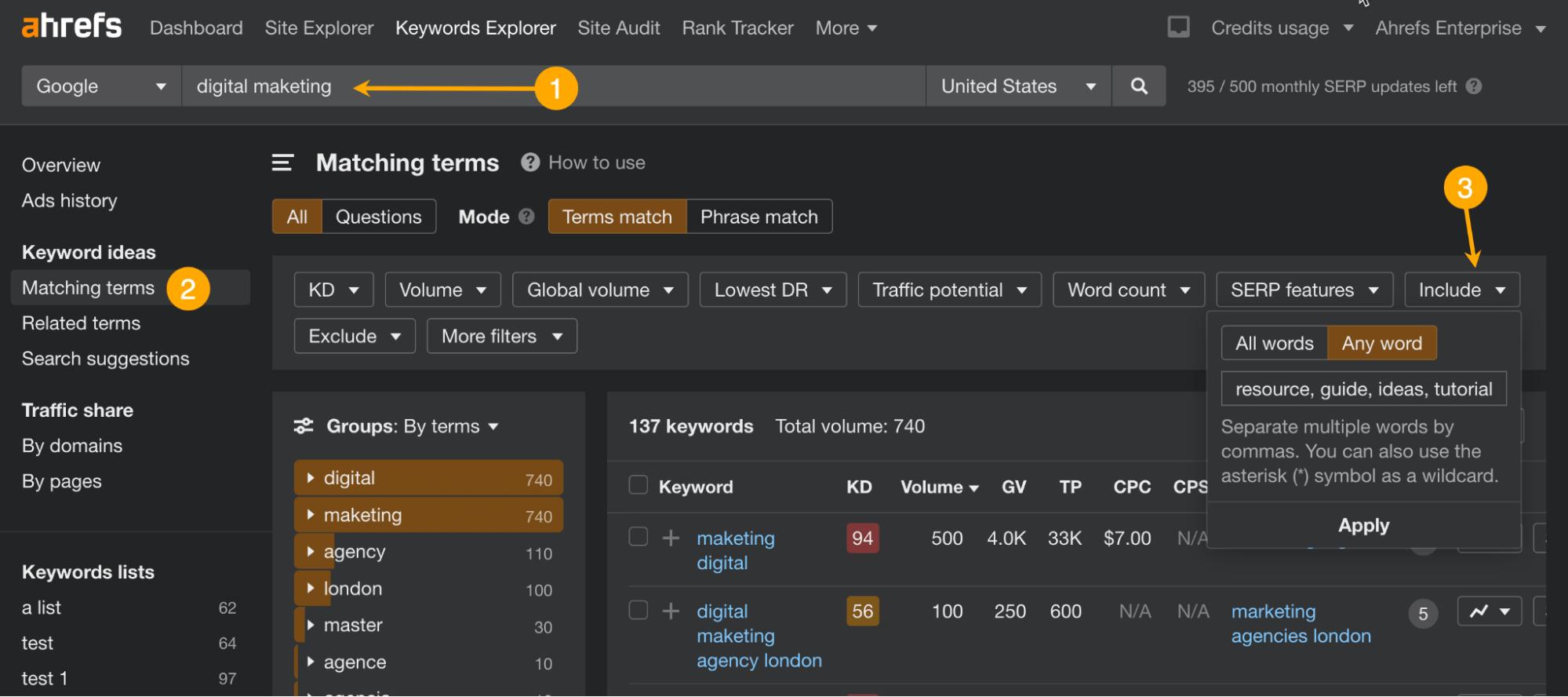
Long-tail keywords are search queries that get a small number of searches per month.
They’ve got their name from the so-called search demand curve. For any topic, the most popular searches are the short-tails (also called the fat heads or the head terms), followed by the middle, and lastly the long-tails.
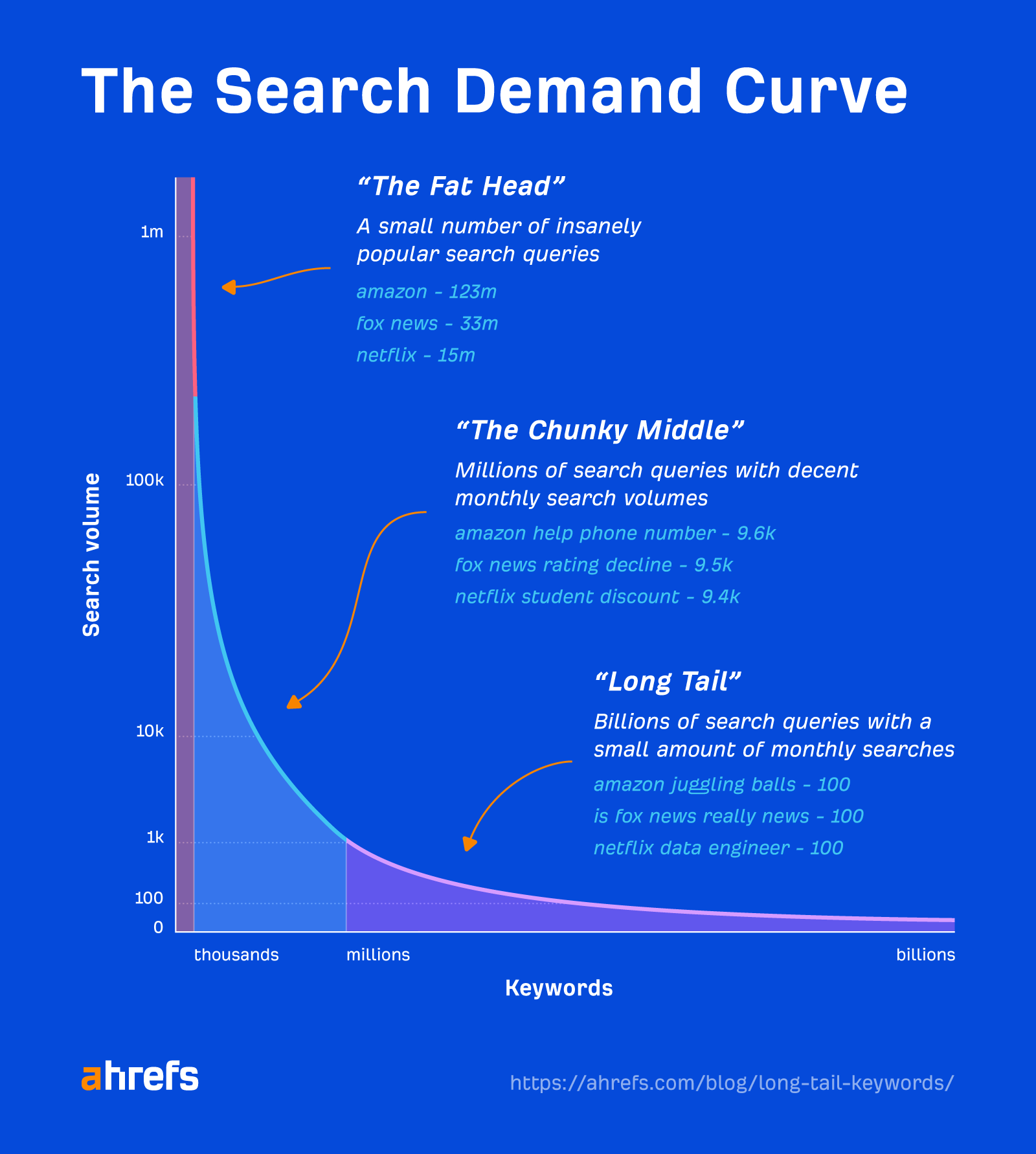
Targeting long-tail keywords is a common tactic in SEO:
- They’re less competitive than the short- or middle-tail (however, not all long-tail keywords are easy to rank for).
- There are lots of them.
- They are usually specific; you can attract visitors with specific intent.
How to find
There are two types of long-tail keywords.
There are topical long-tail keywords, which are topics in themselves. And there are supporting long-tail keywords, which are less popular ways of searching for the topical ones.
It’s an important difference because it only makes sense to target topical long-tail keywords. Here’s an easy way to memorize it: think of them as sets and subsets.
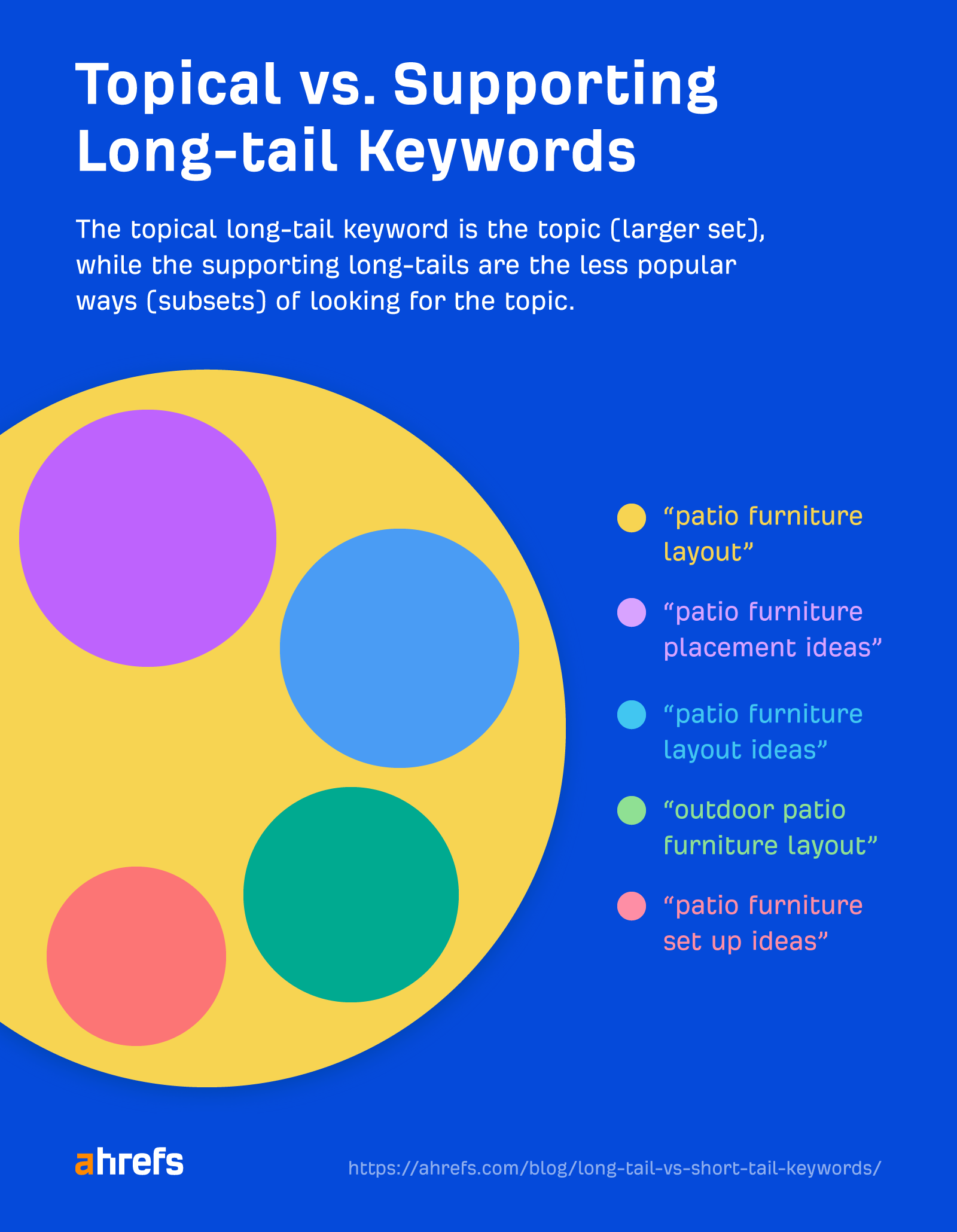
So here’s how to find topical long-tail keywords in Keywords Explorer:
- Enter a broad topic
- Go to the Matching terms report
- Set the Volume and Traffic Potential filters to a maximum of 300
- Browse keywords by Parent Topics
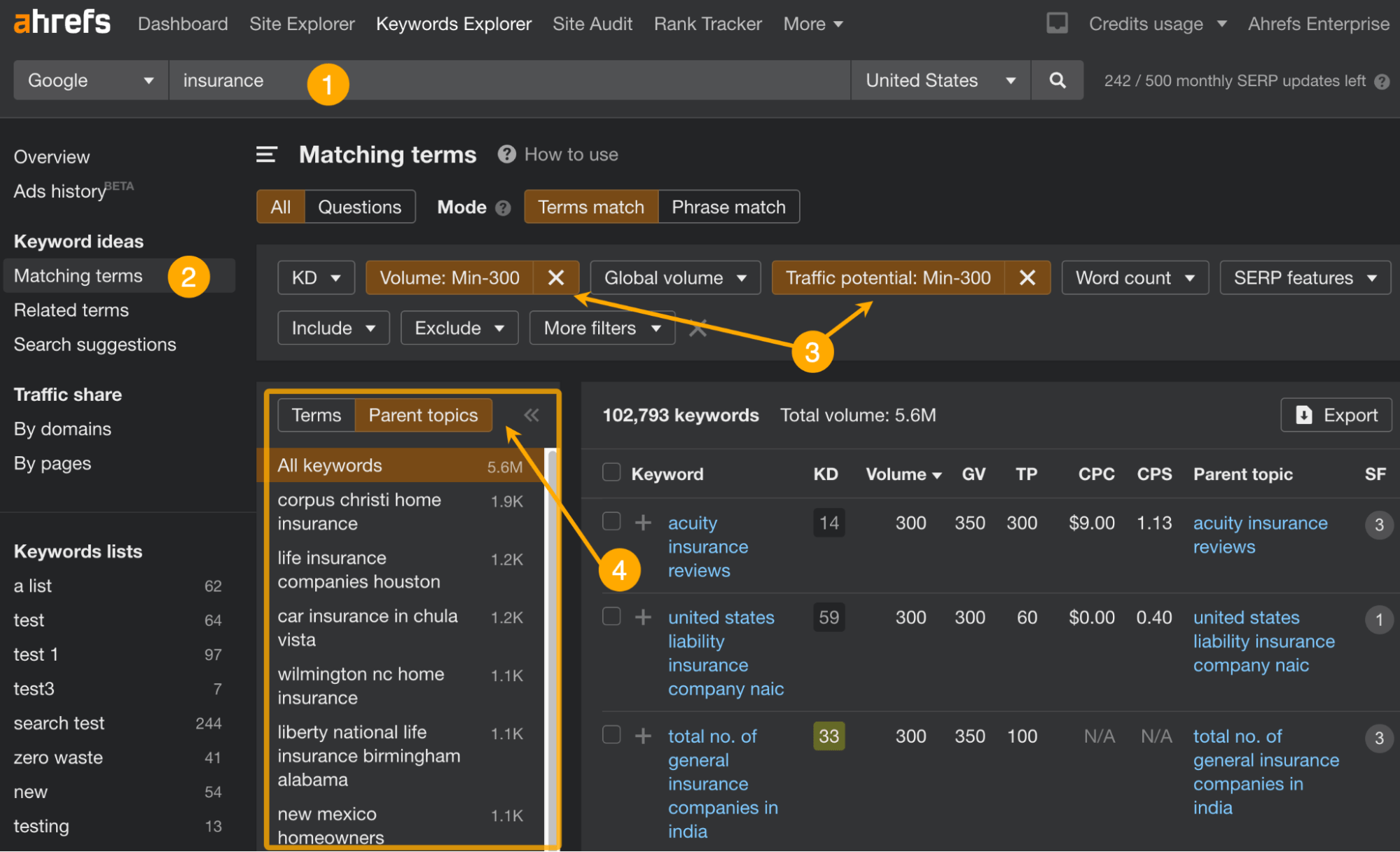
Tip
If you don’t find interesting keywords, try increasing the volume and Traffic Potential. There is no “official” volume threshold for long-tail keywords. It’s largely dependent on the industry. The more search demand the head term has, the longer the “tail.”
Low-competition keywords, or low-hanging keywords, are the keywords that are typically easier to rank for.
Their claim to fame is that they can give faster results in the short term, so they are often recommended to new websites without a strong link profile.
How to find
The easiest way to find low-competition keywords is to use an SEO tool featuring a difficulty score. At Ahrefs, we simply call it Keyword Difficulty (KD).
- Enter a seed keyword
- Go to the Matching terms report
- Set the KD filter to max 20
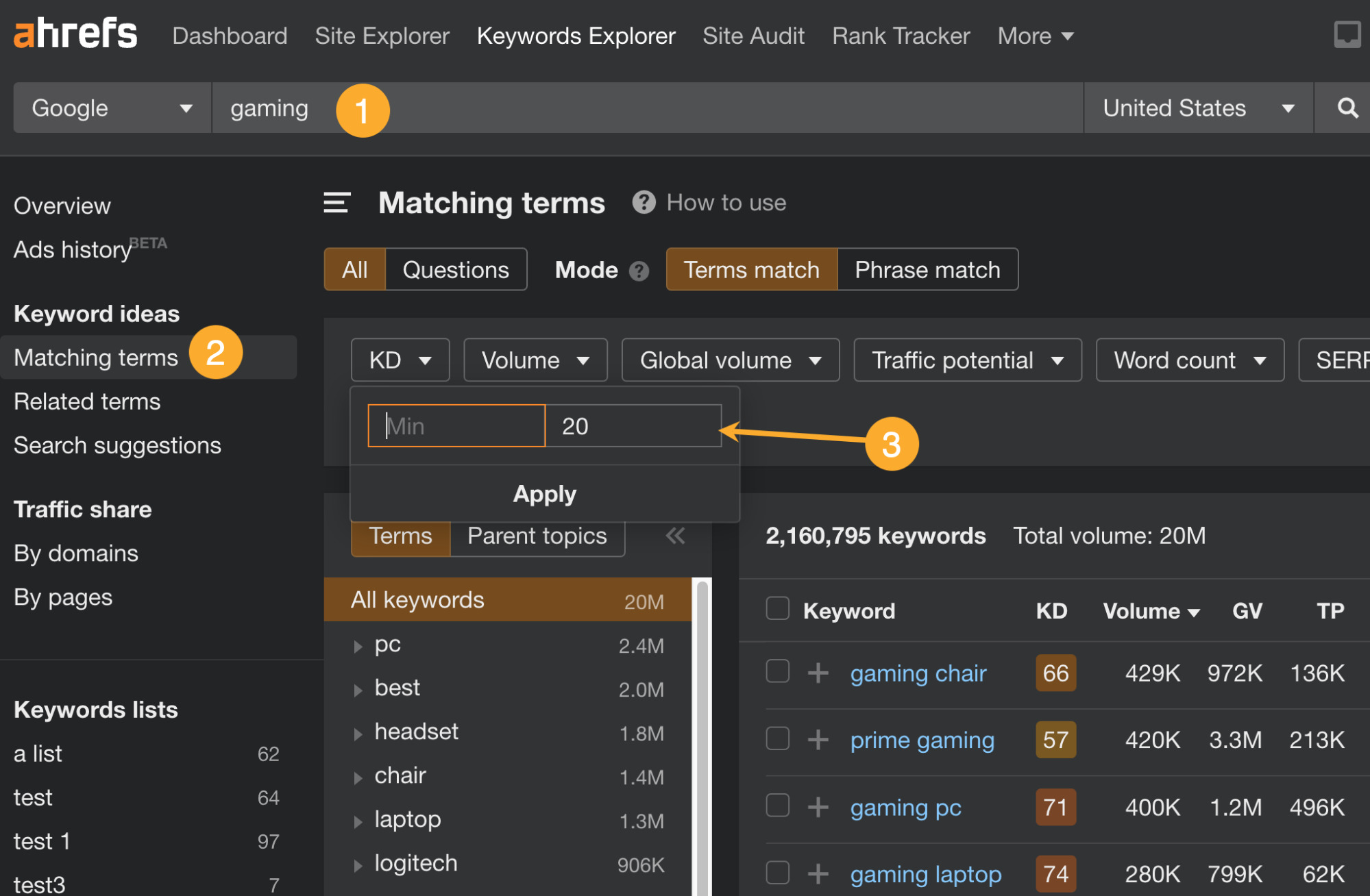
This method will filter out keywords that are dominated by pages with a lot of backlinks. However, there is still a possibility that some of the keywords with low KD will be tougher to rank because of:
- Popular brands on the SERP.
- High content quality from competitors.
You can further refine that list by using the “Lowest DR” filter by inputting your site’s DR. This will show you if websites with your DR or lower already rank in the top 10 or top five.
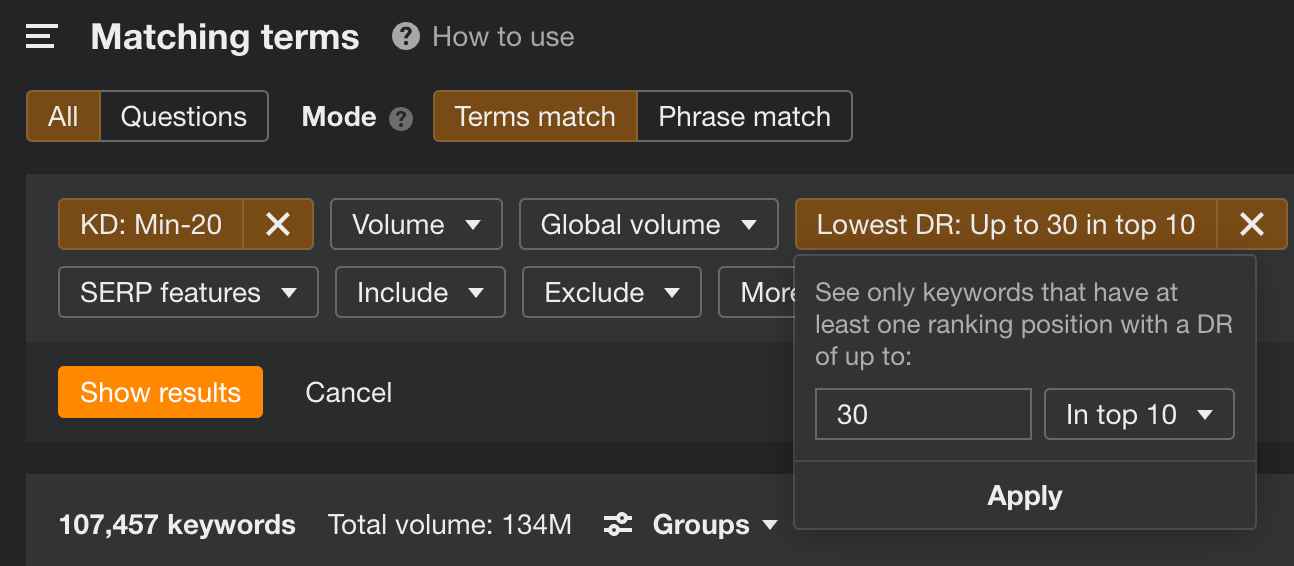
Niche keywords are clear and specific topics that appeal to relatively small, often specialized parts of a given market.
They tend to be easier to rank for. And because of their specificity, they can be high-intent ones. In other words, each niche keyword can send you small but highly qualified traffic in a short time. Put together, they can be a pillar of a long-tail business (selling low volumes of rare items).
Example keyword: “vegan baby soap.” It’s got a low search volume, but it’s very specific. And this product is probably quite rare. So there’s a high chance that the searcher will be in the market for such a product. Plus, it should be quite easy to rank for.
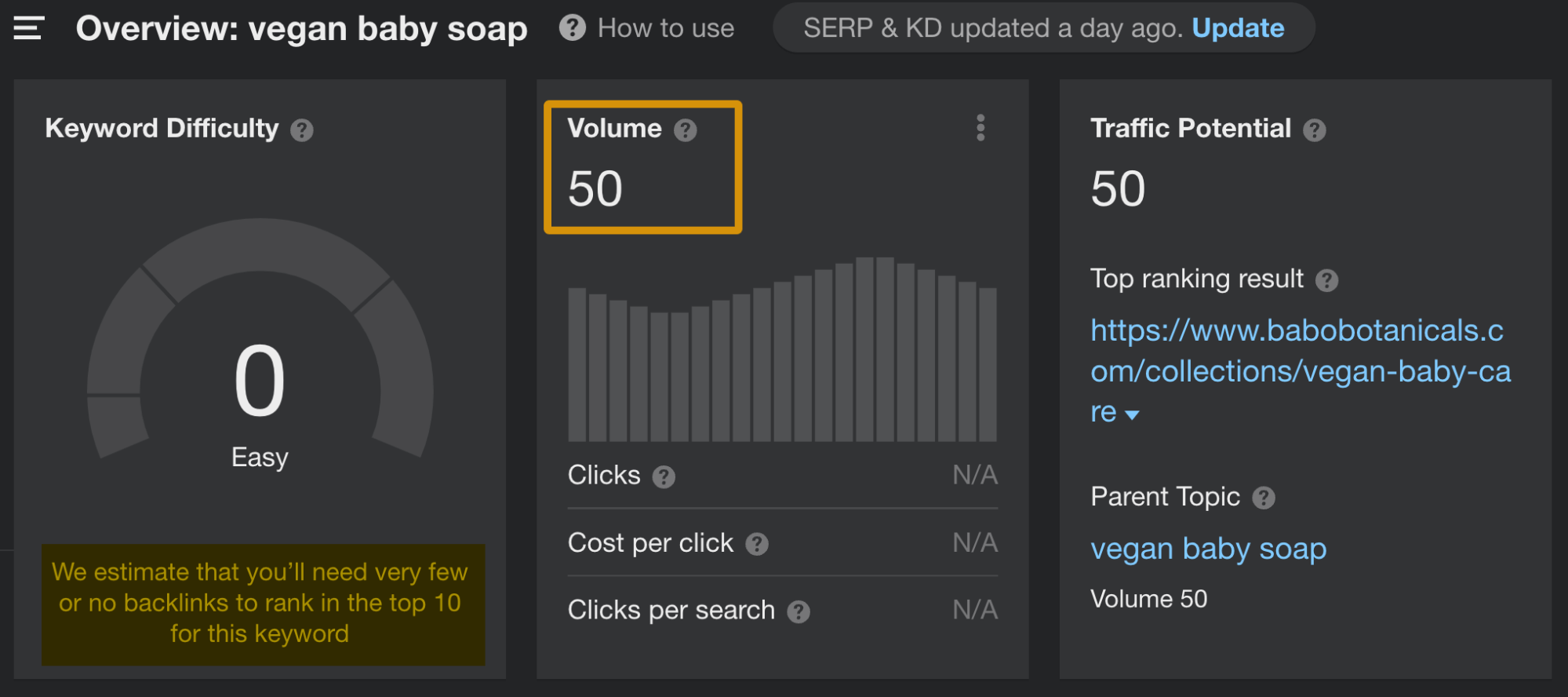
How to find
Niche keywords are similar to long-tail keywords. However, niche keywords are not only about search demand. There’s a market aspect to it, so you’ll need to spend more time researching the actual thing the keyword stands for.
For example, this keyword has traffic potential but doesn’t denote an existing product. It’s a misspelling.
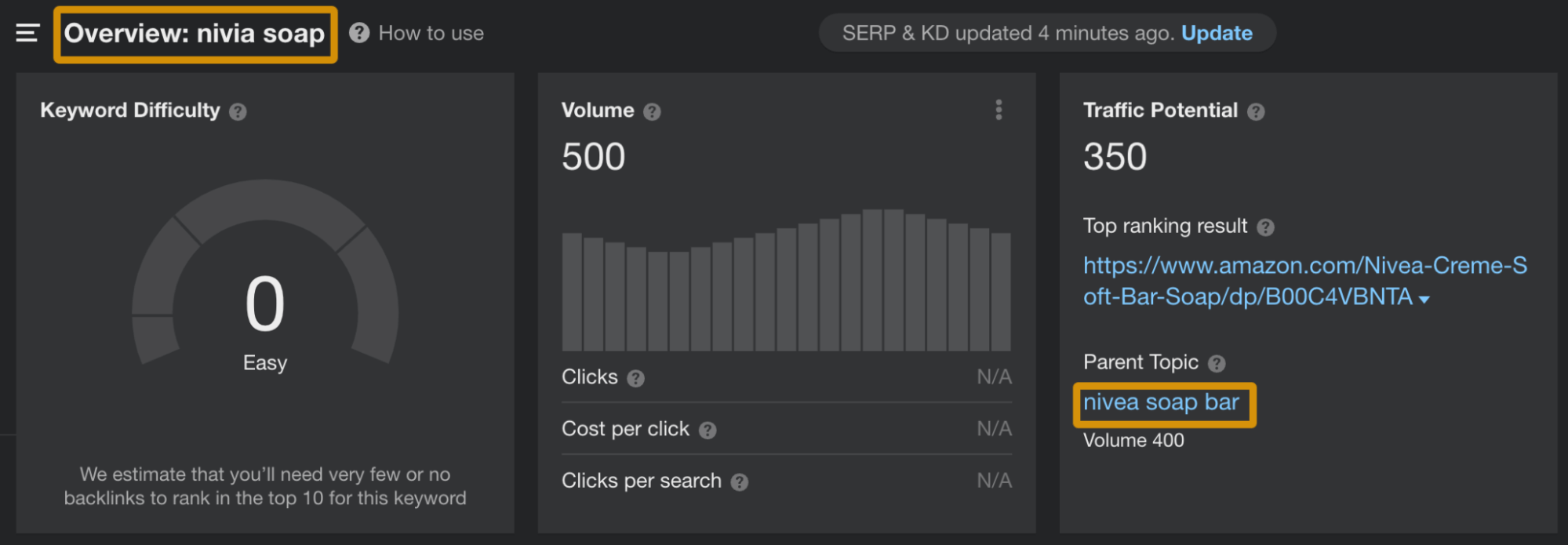
To solve this, you can use a couple of ideas for refining your keyword list. Here’s an example:
- First, enter a seed keyword.
- Set the Volume and Traffic Potential filter to something low. For my example, “soap,” the volume of 500 is quite low.
- Use modifier keywords that refer to use cases, segments, or features. For instance: “alternative,” “for,” “substitute,” “vegan,” “free.”
And this is how we discover a niche for consumers who don’t want their soap to have a fragrance.
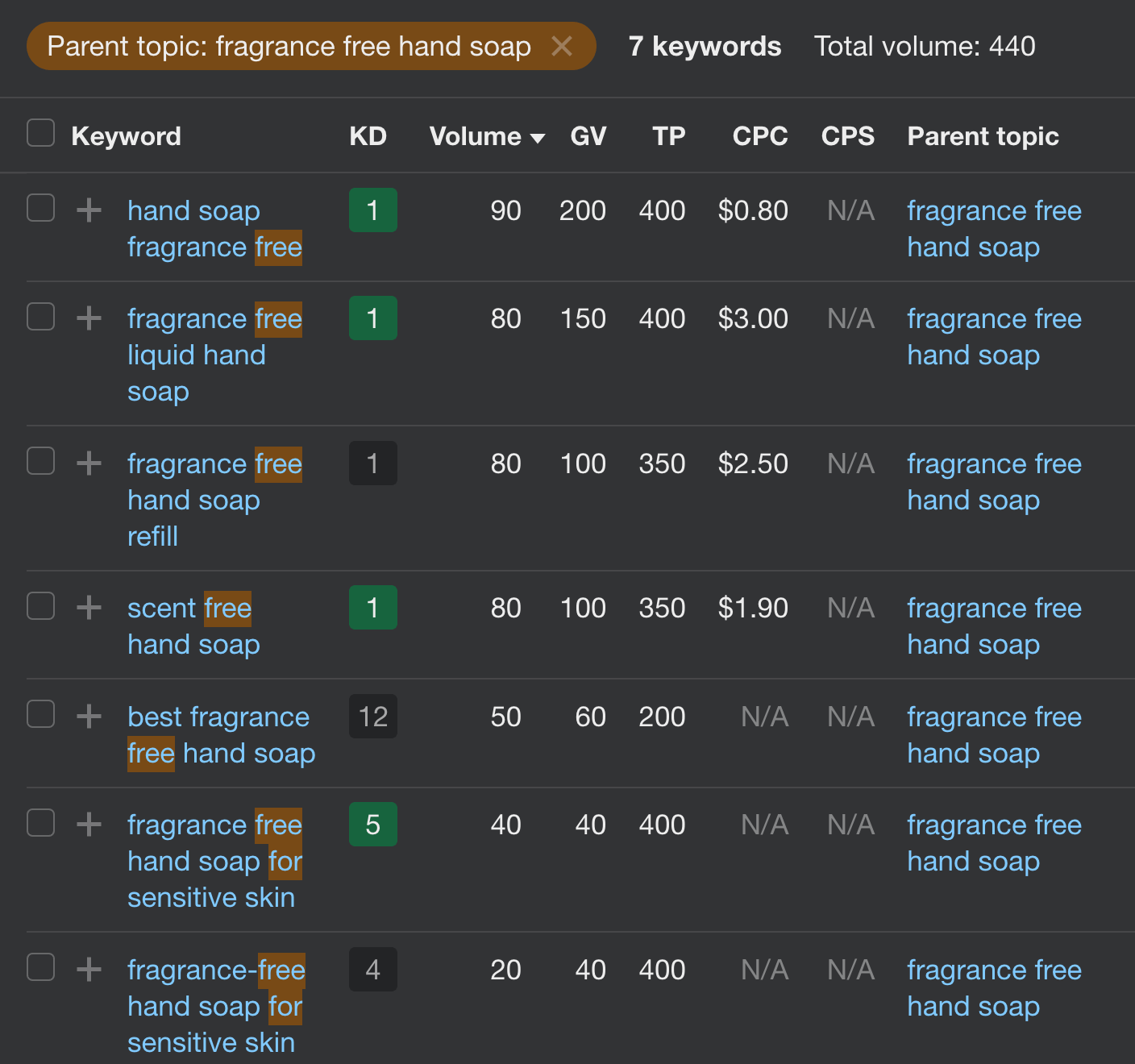
Ranking for non-branded keywords allows you to attract people who are searching for products or services related to your business but may not necessarily know your brand.
Ranking for branded keywords allows you to attract people who are specifically searching for information about your company.
To illustrate the difference:
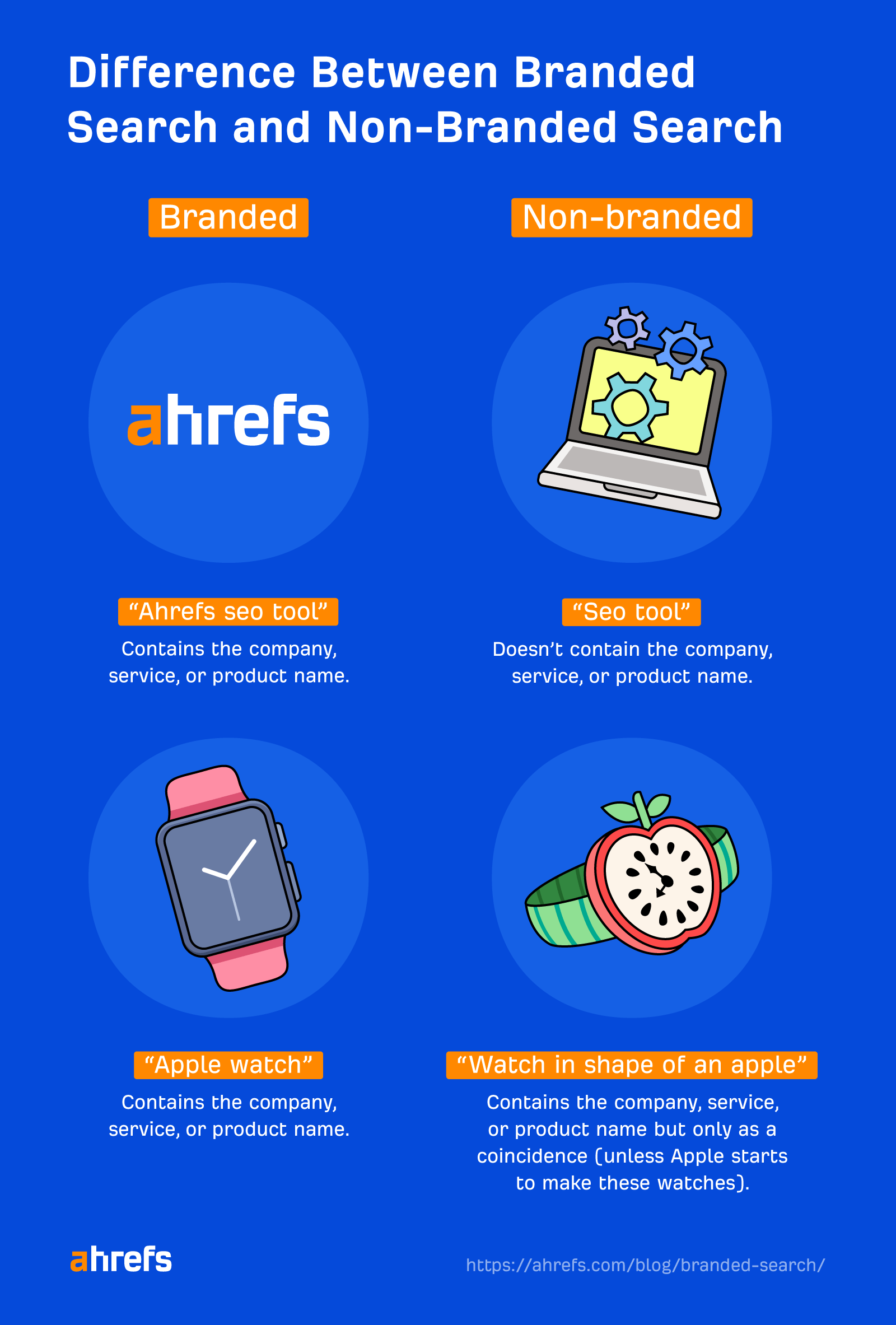
How to find
As long as the keyword doesn’t contain your brand or product’s name, it’s an unbranded keyword. You can choose any of the methods from this article to find those.
To find branded keywords, you’ve got three options.
Option 1. If you paste your brand and products in Keywords Explorer, you will see branded keywords along with their SEO metrics and who ranks for them.
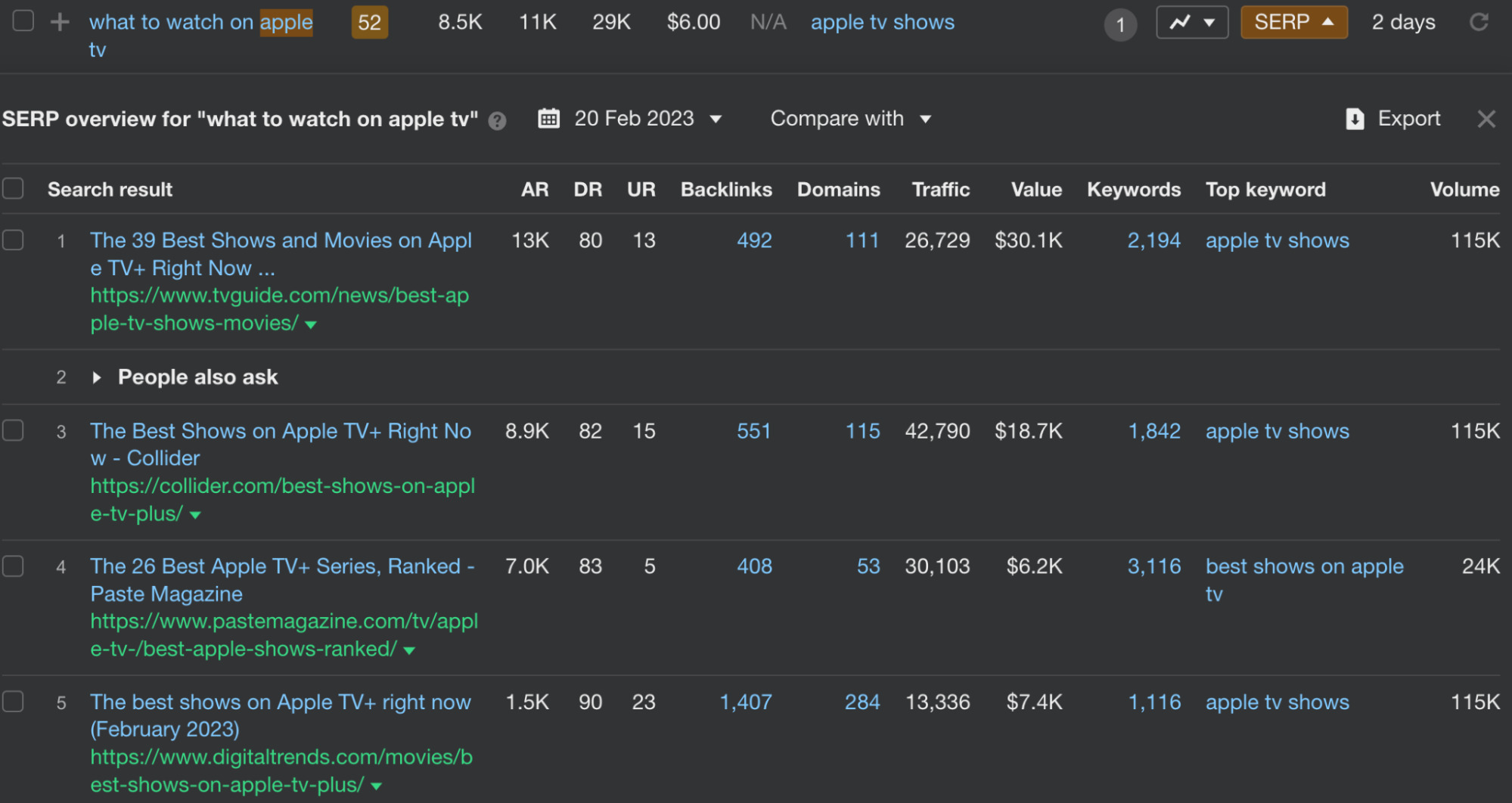
Option 2. You can view only the branded keywords where you rank using Ahrefs’ Site Explorer. Just include the branded words as modifiers. You can also use the Position filter to see underperforming keywords.
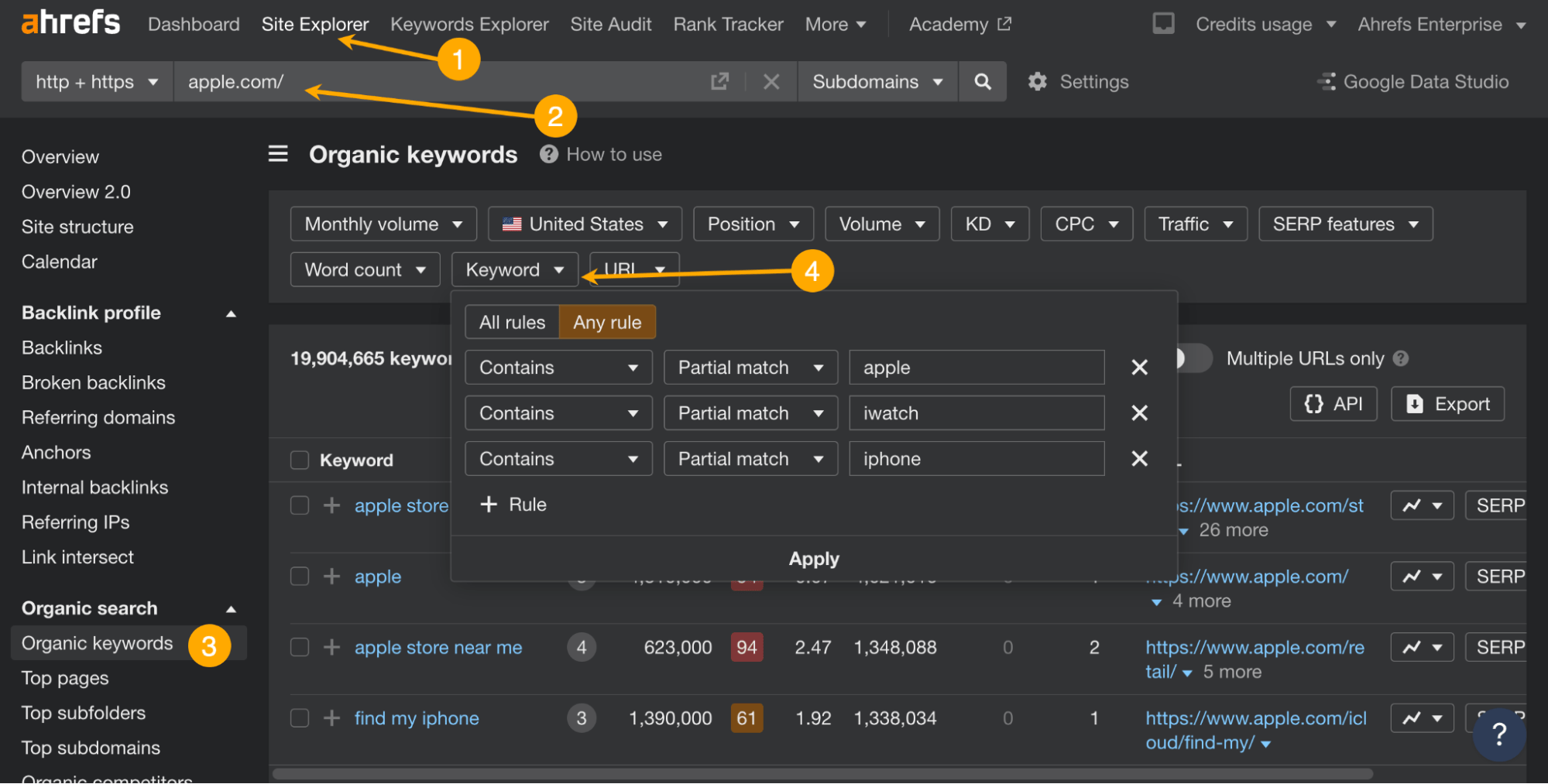
Finally, you can check all the branded keywords where you don’t rank. To do that, you need to compare the list of all branded keywords to the keywords where you rank. Here’s a step-by-step tutorial on how to do this, plus more information on branded search.
Who wouldn’t want to see their competitors’ keywords? Among many reasons, those keywords are a goldmine of topics for your own site.
When you know a competitor’s keywords, you can:
- Target the same keywords.
- Use your competitor’s keywords as seed keywords for research.
How to find
There are two ways.
First, you can go to Site Explorer, paste your competitor’s URL, and go to the Organic keywords report.
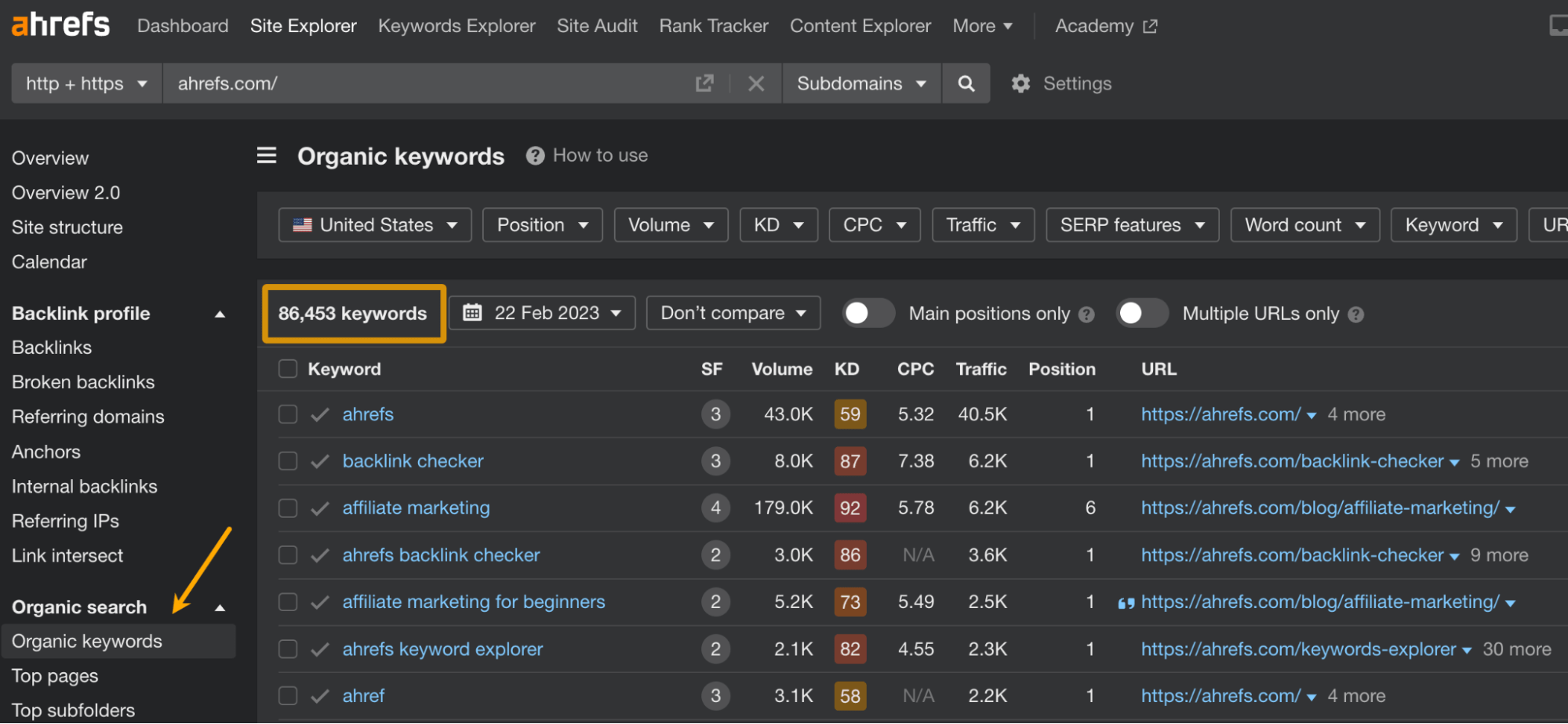
From there, you can use filters to refine the keywords list. For example, low-competition keywords or keywords containing specific words.
You can also view the competitors’ keywords where you don’t rank. In Site Explorer, there’s a special tool for it called Content Gap. All you need to do is paste competing domains.
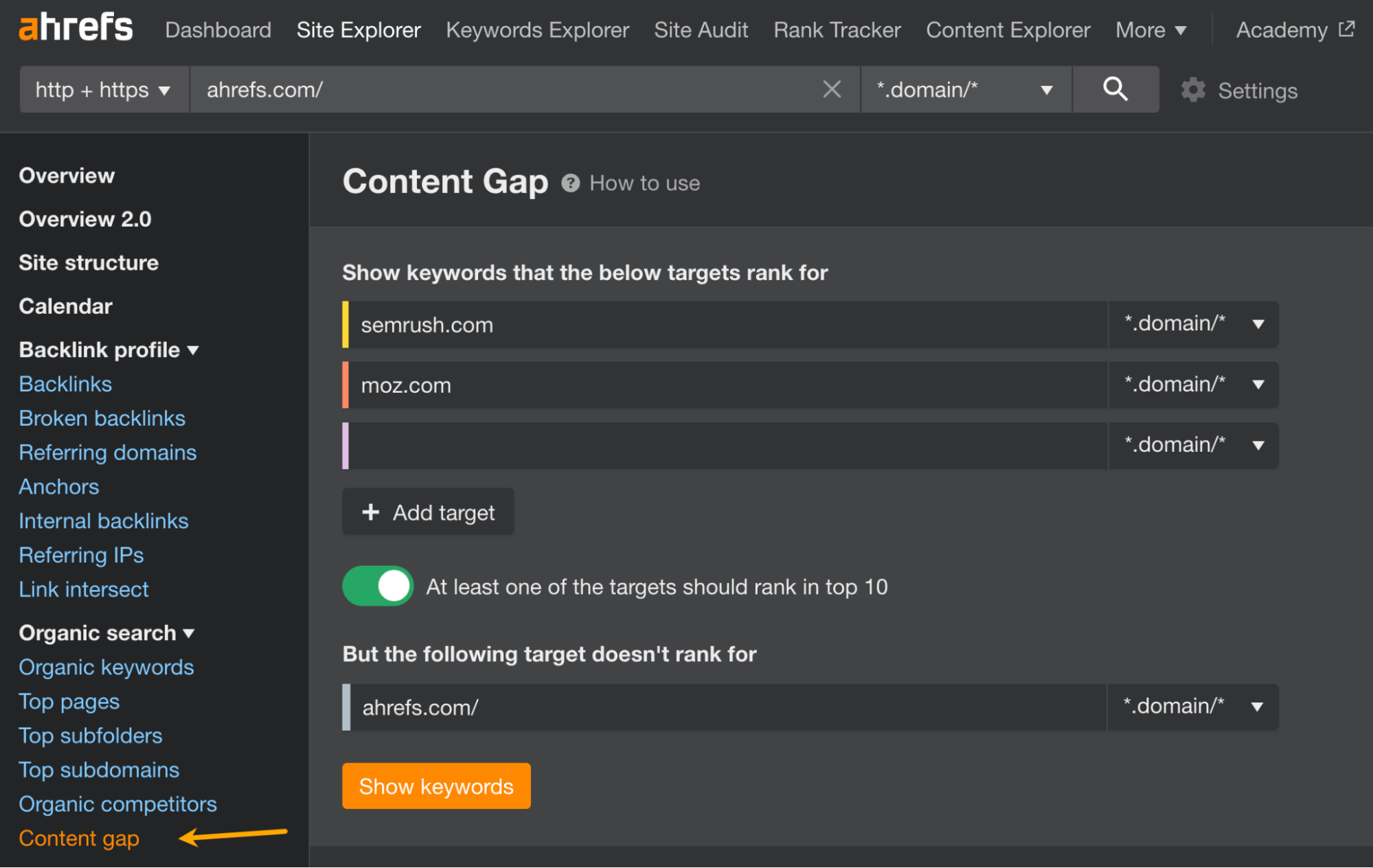
Tip
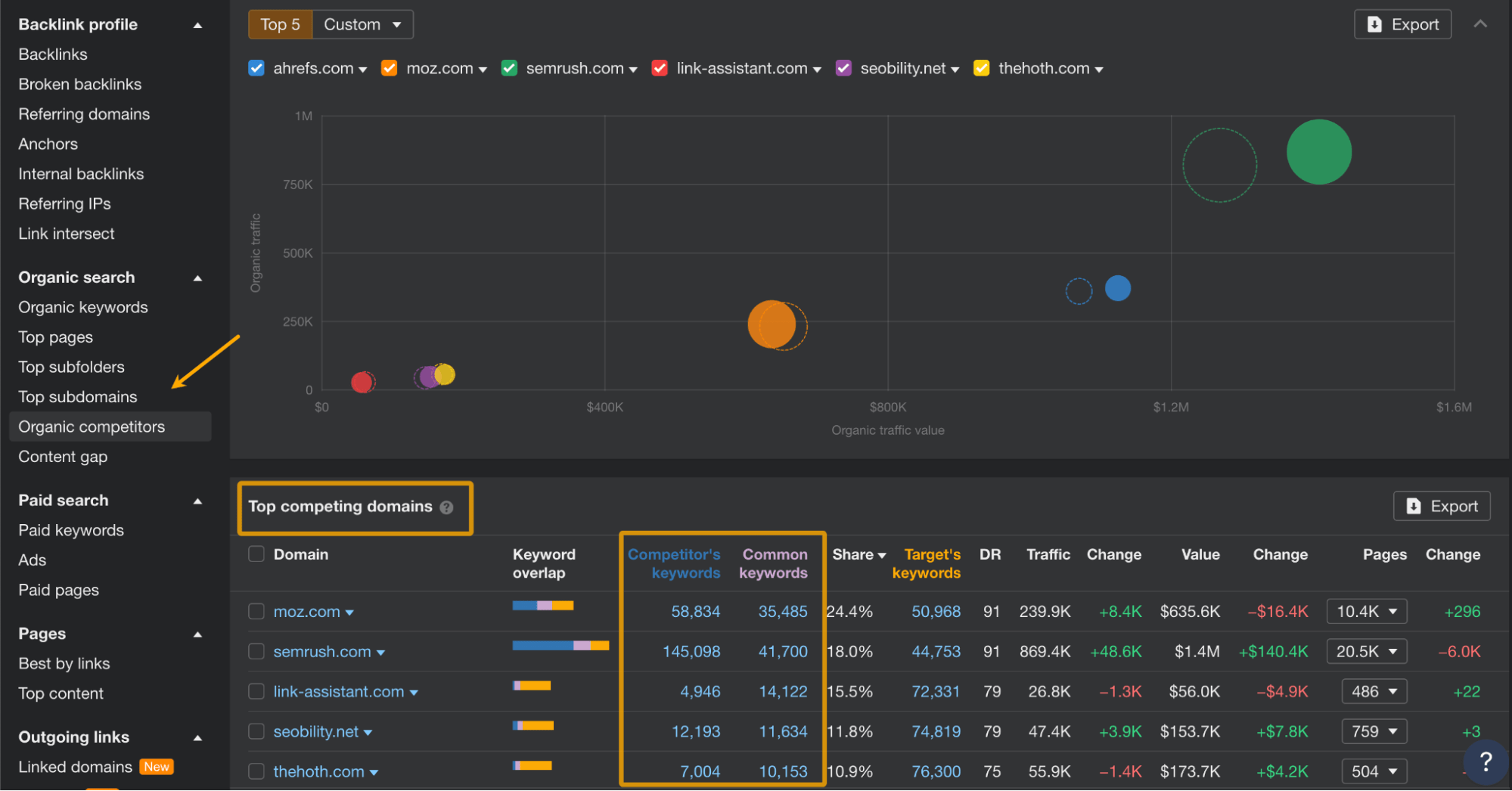
The primary keyword is the main topic of a page. It’s also the single keyword to optimize a page for or, in other words, the reason to do keyword research in the first place.
Secondary keywords are keywords closely related to the primary keyword that you’re targeting with your page.
To illustrate, if the primary keyword is the title of the book, you can use secondary keywords as subtopics.
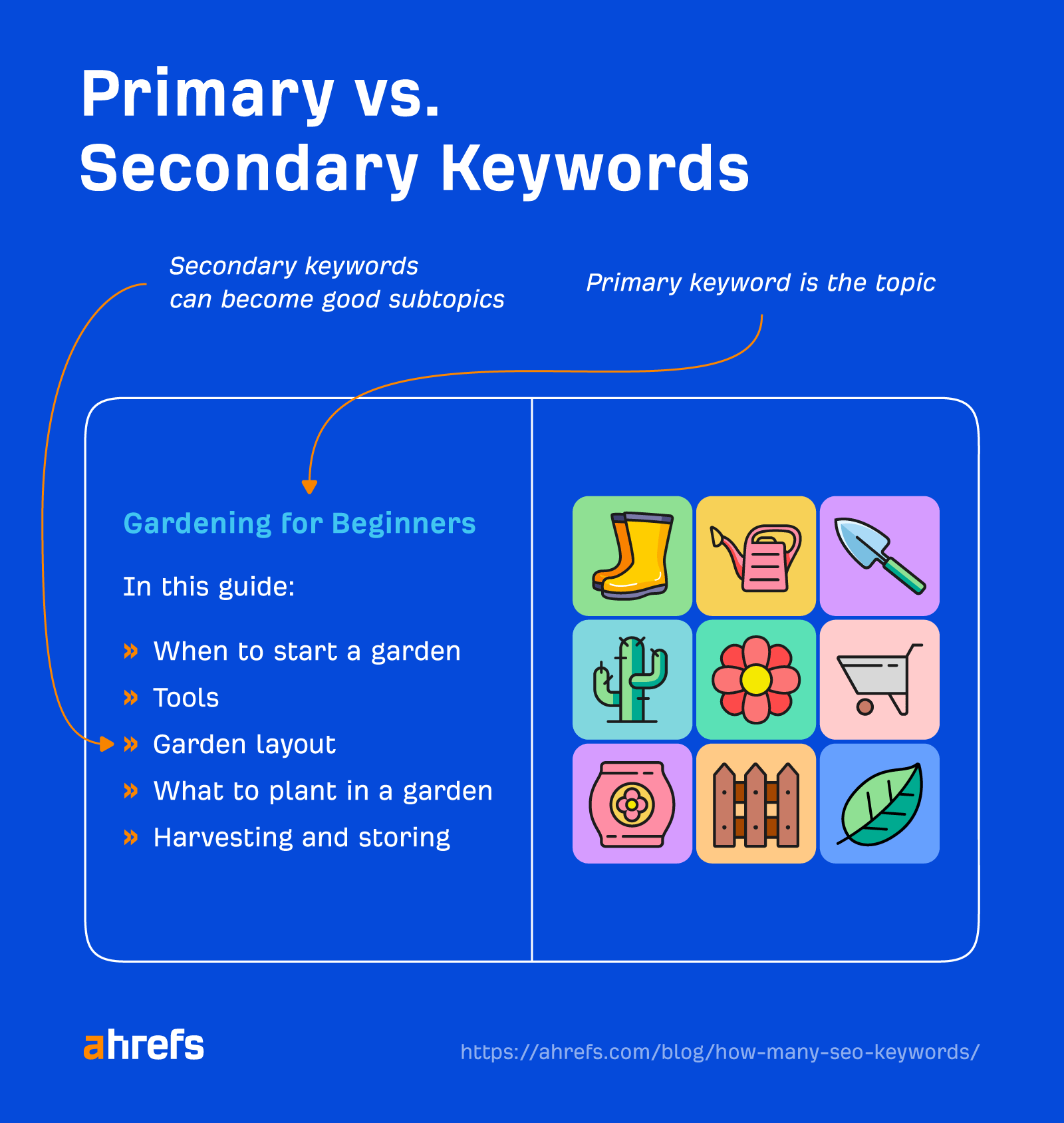
How to find
To find good primary keywords, you need to do proper keyword research. Your primary keywords should:
- Have search traffic potential.
- Show search intent you can align with.
- Have business potential or other value to your website.
- Be within your ranking capabilities (most of the time).
See our full guide on keyword research to learn all the details.
Finding secondary keywords depends on your primary keywords (as these are related). You can use the Related terms report in Keywords Explorer or the Content Gap tool in Site Explorer to compare top-ranking articles for a given keyword.
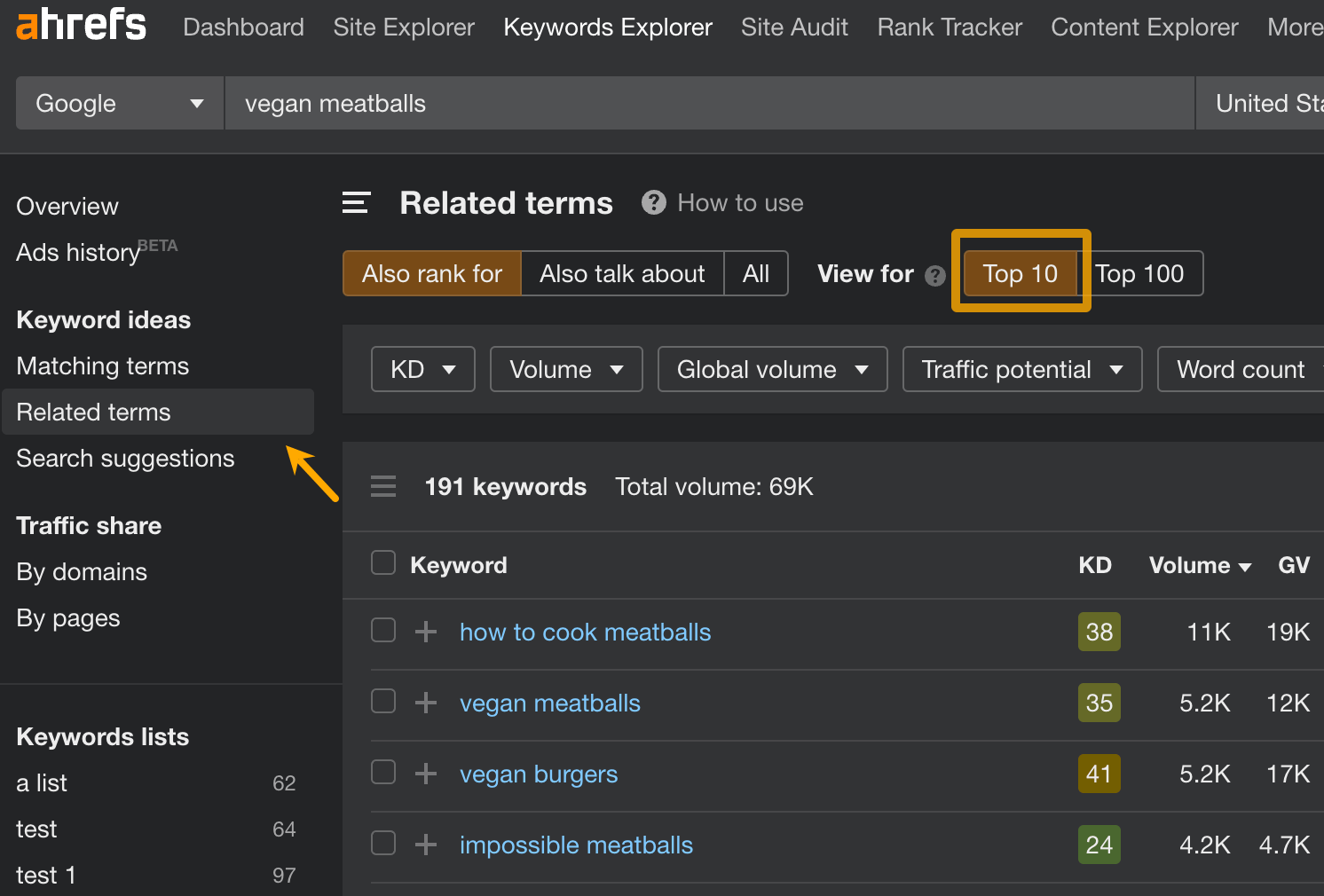
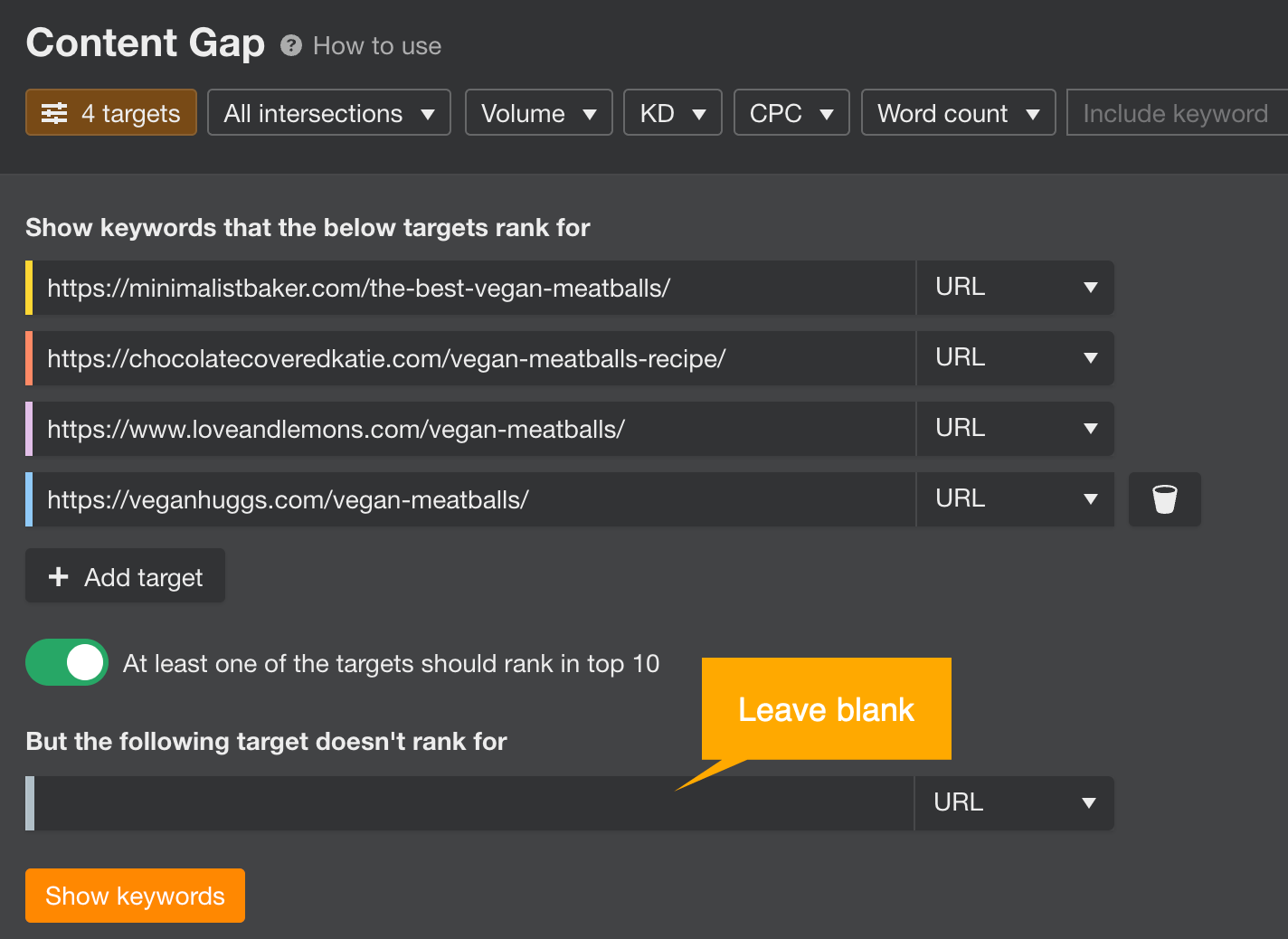
Final thoughts
Those are the eight important types of keywords. Here are a few types that are just worth knowing:
- Zero-volume keywords – If you see an interesting keyword with 0 search volume, it may still be worth targeting if you think its popularity is going to soar or it has high business value to your website (more in our take on zero-volume keywords).
- NORA – No Right Answer keywords may become more important with the rise of AI search engines. Some believe this kind of keyword is where AI-generated responses will take most of the clicks from organic results.
- LSI keywords – A myth of the SEO industry.
- Meta keywords – Worth knowing that they are no longer used by Google to rank pages.
- Paid keywords – Not used for SEO but worth knowing if you’re running paid search ads. You can learn more about their types in this guide to PPC.
Got questions or comments? Ping me on Twitter or Mastodon.
SEO
WordPress Insiders Discuss WordPress Stagnation

A recent webinar featuring WordPress executives from Automattic and Elementor, along with developers and Joost de Valk, discussed the stagnation in WordPress growth, exploring the causes and potential solutions.
Stagnation Was The Webinar Topic
The webinar, “Is WordPress’ Market share Declining? And What Should Product Businesses Do About it?” was a frank discussion about what can be done to increase the market share of new users that are choosing a web publishing platform.
Yet something that came up is that there are some areas that WordPress is doing exceptionally well so it’s not all doom and gloom. As will be seen later on, the fact that the WordPress core isn’t progressing in terms of specific technological adoption isn’t necessarily a sign that WordPress is falling behind, it’s actually a feature.
Yet there is a stagnation as mentioned at the 17:07 minute mark:
“…Basically you’re saying it’s not necessarily declining, but it’s not increasing and the energy is lagging. “
The response to the above statement acknowledged that while there are areas of growth like in the education and government sectors, the rest was “up for grabs.”
Joost de Valk spoke directly and unambiguously acknowledged the stagnation at the 18:09 minute mark:
“I agree with Noel. I think it’s stagnant.”
That said, Joost also saw opportunities with ecommerce, with the performance of WooCommerce. WooCommerce, by the way, outperformed WordPress as a whole with a 6.80% year over year growth rate, so there’s a good reason that Joost was optimistic of the ecommerce sector.
A general sense that WordPress was entering a stall however was not in dispute, as shown in remarks at the 31:45 minute mark:
“… the WordPress product market share is not decreasing, but it is stagnating…”
Facing Reality Is Productive
Humans have two ways to deal with a problem:
- Acknowledge the problem and seek solutions
- Pretend it’s not there and proceed as if everything is okay
WordPress is a publishing platform that’s loved around the world and has literally created countless jobs, careers, powered online commerce as well as helped establish new industries in developing applications that extend WordPress.
Many people have a stake in WordPress’ continued survival so any talk about WordPress entering a stall and descent phase like an airplane that reached the maximum altitude is frightening and some people would prefer to shout it down to make it go away.
Acknowledging facts and not brushing them aside is what this webinar achieved as a step toward identifying solutions. Everyone in the discussion has a stake in the continued growth of WordPress and their goal was to put it out there for the community to also get involved.
The live webinar featured:
- Miriam Schwab, Elementor’s Head of WP Relations
- Rich Tabor, Automattic Product Manager
- Joost de Valk, founder of Yoast SEO
- Co-hosts Matt Cromwell and Amber Hinds, both members of the WordPress developer community moderated the discussion.
WordPress Market Share Stagnation
The webinar acknowledged that WordPress market share, the percentage of websites online that use WordPress, was stagnating. Stagnation is a state at which something is neither moving forward nor backwards, it is simply stuck at an in between point. And that’s what was openly acknowledged and the main point of the discussion was understanding the reasons why and what could be done about it.
Statistics gathered by the HTTPArchive and published on Joost de Valk’s blog show that WordPress experienced a year over year growth of 1.85%, having spent the year growing and contracting its market share. For example, over the latest month over month period the market share dropped by -0.28%.
Crowing about the WordPress 1.85% growth rate as evidence that everything is fine is to ignore that a large percentage of new businesses and websites coming online are increasingly going to other platforms, with year over year growth rates of other platforms outpacing the rate of growth of WordPress.
Out of the top 10 Content Management Systems, only six experienced year over year (YoY) growth.
CMS YoY Growth
- Webflow: 25.00%
- Shopify: 15.61%
- Wix: 10.71%
- Squarespace: 9.04%
- Duda: 8.89%
- WordPress: 1.85%
Why Stagnation Is A Problem
An important point made in the webinar is that stagnation can have a negative trickle-down effect on the business ecosystem by reducing growth opportunities and customer acquisition. If fewer of the new businesses coming online are opting in for WordPress are clients that will never come looking for a theme, plugin, development or SEO service.
It was noted at the 4:18 minute mark by Joost de Valk:
“…when you’re investing and when you’re building a product in the WordPress space, the market share or whether WordPress is growing or not has a deep impact on how easy it is to well to get people to, to buy the software that you want to sell them.”
Perception Of Innovation
One of the potential reasons for the struggle to achieve significant growth is the perception of a lack of innovation, pointed out at the 16:51 minute mark that there’s still no integration with popular technologies like Next JS, an open-source web development platform that is optimized for fast rollout of scalable and search-friendly websites.
It was observed at the 16:51 minute mark:
“…and still today we have no integration with next JS or anything like that…”
Someone else agreed but also expressed at the 41:52 minute mark, that the lack of innovation in the WordPress core can also be seen as a deliberate effort to make WordPress extensible so that if users find a gap a developer can step in and make a plugin to make WordPress be whatever users and developers want it to be.
“It’s not trying to be everything for everyone because it’s extensible. So if WordPress has a… let’s say a weakness for a particular segment or could be doing better in some way. Then you can come along and develop a plug in for it and that is one of the beautiful things about WordPress.”
Is Improved Marketing A Solution
One of the things that was identified as an area of improvement is marketing. They didn’t say it would solve all problems. It was simply noted that competitors are actively advertising and promoting but WordPress is by comparison not really proactively there. I think to extend that idea, which wasn’t expressed in the webinar, is to consider that if WordPress isn’t out there putting out a positive marketing message then the only thing consumers might be exposed to is the daily news of another vulnerability.
Someone commented in the 16:21 minute mark:
“I’m missing the excitement of WordPress and I’m not feeling that in the market. …I think a lot of that is around the product marketing and how we repackage WordPress for certain verticals because this one-size-fits-all means that in every single vertical we’re being displaced by campaigns that have paid or, you know, have received a a certain amount of funding and can go after us, right?”
This idea of marketing being a shortcoming of WordPress was raised earlier in the webinar at the 18:27 minute mark where it was acknowledged that growth was in some respects driven by the WordPress ecosystem with associated products like Elementor driving the growth in adoption of WordPress by new businesses.
They said:
“…the only logical conclusion is that the fact that marketing of WordPress itself is has actually always been a pain point, is now starting to actually hurt us.”
Future Of WordPress
This webinar is important because it features the voices of people who are actively involved at every level of WordPress, from development, marketing, accessibility, WordPress security, to plugin development. These are insiders with a deep interest in the continued evolution of WordPress as a viable platform for getting online.
The fact that they’re talking about the stagnation of WordPress should be of concern to everybody and that they are talking about solutions shows that the WordPress community is not in denial but is directly confronting situations, which is how a thriving ecosystem should be responding.
Watch the webinar:
Is WordPress’ Market share Declining? And What Should Product Businesses Do About it?
Featured Image by Shutterstock/Krakenimages.com
SEO
Google’s New Support For AVIF Images May Boost SEO

Google announced that images in the AVIF file format will now be eligible to be shown in Google Search and Google Images, including all platforms that surface Google Search data. AVIF will dramatically lower image sizes and improve Core Web Vitals scores, particularly Largest Contentful Paint.
How AVIF Can Improve SEO
Getting pages crawled and indexed are the first step of effective SEO. Anything that lowers file size and speeds up web page rendering will help search crawlers get to the content faster and improve the amount of pages crawled.
Google’s crawl budget documentation recommends increasing the speeds of page loading and rendering as a way to avoid receiving “Hostload exceeded” warnings.
It also says that faster loading times enables Googlebot to crawl more pages:
Improve your site’s crawl efficiency
Increase your page loading speed
Google’s crawling is limited by bandwidth, time, and availability of Googlebot instances. If your server responds to requests quicker, we might be able to crawl more pages on your site.
What Is AVIF?
AVIF (AVI Image File Format) is a next generation open source image file format that combines the best of JPEG, PNG, and GIF image file formats but in a more compressed format for smaller image files (by 50% for JPEG format).
AVIF supports transparency like PNG and photographic images like JPEG does but does but with a higher level of dynamic range, deeper blacks, and better compression (meaning smaller file sizes). AVIF even supports animation like GIF does.
AVIF Versus WebP
AVIF is generally a better file format than WebP in terms of smaller files size (compression) and image quality. WebP is better for lossless images, where maintaining high quality regardless of file size is more important. But for everyday web usage, AVIF is the better choice.
See also: 12 Important Image SEO Tips You Need To Know
Is AVIF Supported?
AVIF is currently supported by Chrome, Edge, Firefox, Opera, and Safari browsers. Not all content management systems support AVIF. However, both WordPress and Joomla support AVIF. In terms of CDN, Cloudflare also already supports AVIF.
I couldn’t at this time ascertain whether Bing supports AVIF files and will update this article once I find out.
Current website usage of AVIF stands at 0.2% but now that it’s available to surfaced in Google Search, expect that percentage to grow. AVIF images will probably become a standard image format because of its high compression will help sites perform far better than they currently do with JPEG and PNG formats.
Research conducted in July 2024 by Joost de Valk (founder of Yoast, ) discovered that social media platforms don’t all support AVIF files. He found that LinkedIn, Mastodon, Slack, and Twitter/X do not currently support AVIF but that Facebook, Pinterest, Threads and WhatsApp do support it.
AVIF Images Are Automatically Indexable By Google
According to Google’s announcement there is nothing special that needs to be done to make AVIF image files indexable.
“Over the recent years, AVIF has become one of the most commonly used image formats on the web. We’re happy to announce that AVIF is now a supported file type in Google Search, for Google Images as well as any place that uses images in Google Search. You don’t need to do anything special to have your AVIF files indexed by Google.”
Read Google’s announcement:
Supporting AVIF in Google Search
Featured Image by Shutterstock/Cast Of Thousands
SEO
CMOs Called Out For Reliance On AI Content For SEO

Eli Schwartz, Author of Product-Led SEO, started a discussion on LinkedIn about there being too many CMOs (Chief Marketing Officers) who believe that AI written content is an SEO strategy. He predicted that there will be reckoning on the way after their strategies end in failure.
This is what Eli had to say:
“Too many CMOs think that AI-written content is an SEO strategy that will replace actual SEO.
This mistake is going to lead to an explosion in demand for SEO strategists to help them fix their traffic when they find out they might have been wrong.”
Everyone in the discussion, which received 54 comments, strongly agreed with Eli, except for one guy.
What Is Google’s Policy On AI Generated Content?
Google’s policy hasn’t changed although they did update their guidance and spam policies on March 5, 2024 at the same time as the rollout of the March 2024 Core Algorithm Update. Many publishers who used AI to create content subsequently reported losing rankings.
Yet it’s not said that using AI is enough to merit poor rankings, it’s content that is created for ranking purposes.
Google wrote these guidelines specifically for autogenerated content, including AI generated content (Wayback machine copy dated March 6, 2024)
“Our long-standing spam policy has been that use of automation, including generative AI, is spam if the primary purpose is manipulating ranking in Search results. The updated policy is in the same spirit of our previous policy and based on the same principle. It’s been expanded to account for more sophisticated scaled content creation methods where it isn’t always clear whether low quality content was created purely through automation.
Our new policy is meant to help people focus more clearly on the idea that producing content at scale is abusive if done for the purpose of manipulating search rankings and that this applies whether automation or humans are involved.”
Many in Eli’s discussion were in agreement that reliance on AI by some organizations may come to haunt them, except for that one guy in the discussion
Read the discussion on LinkedIn:
Too many CMOs think that AI-written content is an SEO strategy that will replace actual SEO
Featured Image by Shutterstock/Cast Of Thousands
-

 SEO7 days ago
SEO7 days agoGoogle’s Revamped Documentation Shows 4 Reasons To Refresh Content
-
SEARCHENGINES5 days ago
Daily Search Forum Recap: August 26, 2024
-

 SEARCHENGINES7 days ago
SEARCHENGINES7 days agoGoogle Ranking Bug Fixed, August Core Update Swings, AI Overviews, Google Ads Bug & More
-

 WORDPRESS7 days ago
WORDPRESS7 days agoHow to Secure Your WordPress Store
-
SEARCHENGINES4 days ago
Daily Search Forum Recap: August 27, 2024
-

 AFFILIATE MARKETING7 days ago
AFFILIATE MARKETING7 days agoBusiness Owners are Batting 1,000 With This All-in-One Management Hub
-

 SEARCHENGINES6 days ago
SEARCHENGINES6 days agoGoogle Migrating All To Google Merchant Center Next By September
-

 WORDPRESS5 days ago
WORDPRESS5 days ago10 Best StudioPress Alternatives (Genesis Framework)














